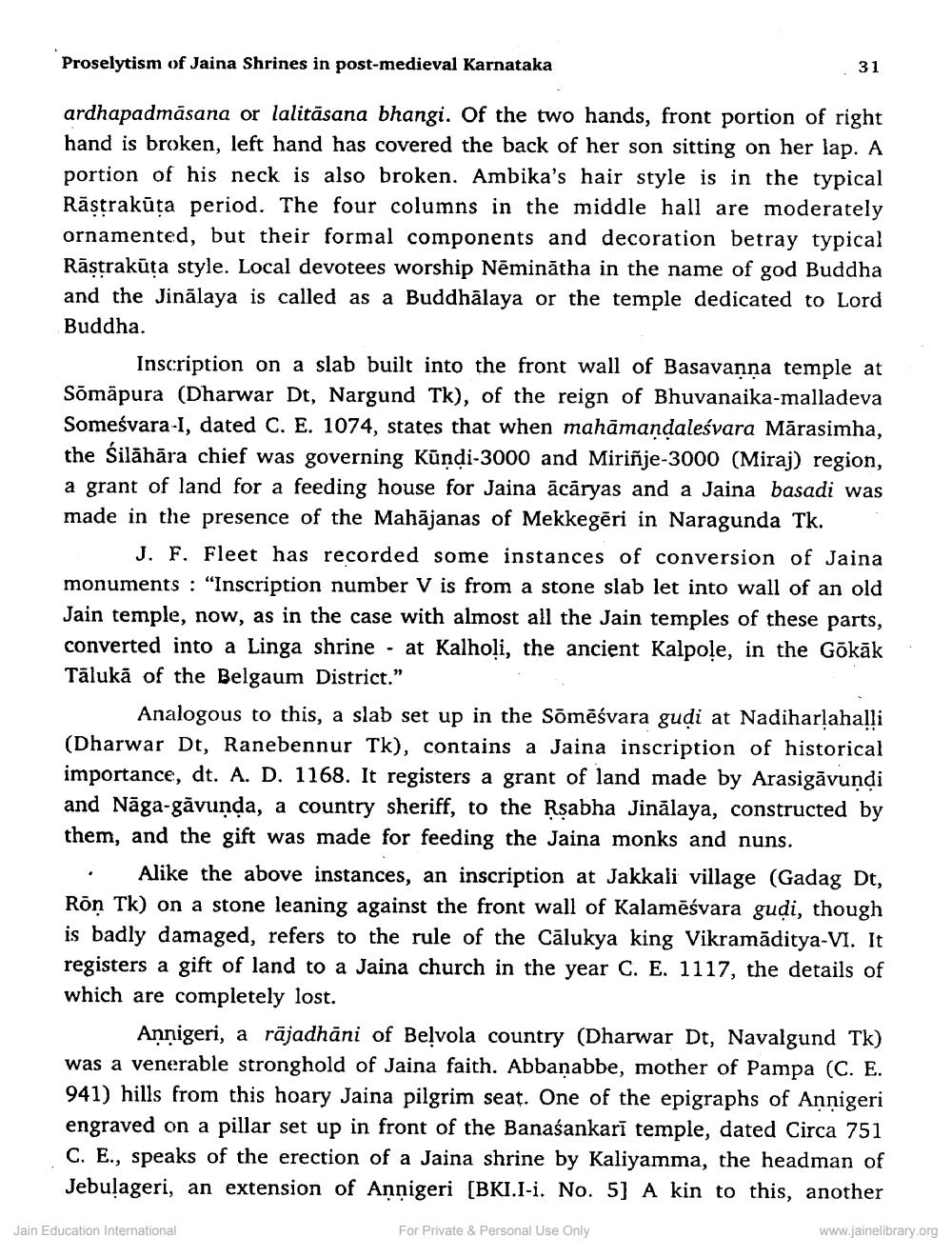________________
Proselytism of Jaina Shrines in post-medieval Karnataka
31
ardhapadmāsana or lalitāsana bhangi. Of the two hands, front portion of right hand is broken, left hand has covered the back of her son sitting on her lap. A portion of his neck is also broken. Ambika's hair style is in the typical Răstrakūta period. The four columns in the middle hall are moderately ornamented, but their formal components and decoration betray typical Rāstrakūta style. Local devotees worship Nēminātha in the name of god Buddha and the Jinālaya is called as a Buddhālaya or the temple dedicated to Lord Buddha.
Inscription on a slab built into the front wall of Basavanna temple at Sömäpura (Dharwar Dt, Nargund Tk), of the reign of Bhuvanaika-malladeva Someśvara-I, dated C. E. 1074, states that when mahāmandaleśvara Mārasimha, the silāhāra chief was governing Kūndi-3000 and Miriñje-3000 (Miraj) region, a grant of land for a feeding house for Jaina ācāryas and a Jaina basadi was made in the presence of the Mahājanas of Mekkegēri in Naragunda Tk.
J. F. Fleet has recorded some instances of conversion of Jaina monuments : "Inscription number V is from a stone slab let into wall of an old Jain temple, now, as in the case with almost all the Jain temples of these parts, converted into a Linga shrine - at Kalholi, the ancient Kalpole, in the Gōkāk Tālukā of the Belgaum District.”
Analogous to this, a slab set up in the Somēśvara guļi at Nadiharlahalli (Dharwar Dt, Ranebennur Tk), contains a Jaina inscription of historical importance, dt. A. D. 1168. It registers a grant of land made by Arasigāvundi and Nāga-gāvunda, a country sheriff, to the Rsabha Jinālaya, constructed by them, and the gift was made for feeding the Jaina monks and nuns.
• Alike the above instances, an inscription at Jakkali village (Gadag Dt, Ron Tk) on a stone leaning against the front wall of Kalamēśvara gudi, though is badly damaged, refers to the rule of the Cālukya king Vikramāditya-Vi. It registers a gift of land to a Jaina church in the year C. E. 1117, the d which are completely lost.
Annigeri, a rājadhāni of Belvola country (Dharwar Dt, Navalgund Tk) was a venerable stronghold of Jaina faith. Abbanabbe, mother of Pampa (C. E. 941) hills from this hoary Jaina pilgrim seat. One of the epigraphs of Annigeri engraved on a pillar set up in front of the Banaśankarī temple, dated Circa 751 C. E., speaks of the erection of a Jaina shrine by Kaliyamma, the headman of Jebulageri, an extension of Annigeri (BKI.I-i. No. 5] A kin to this, another
Jain Education International
For Private & Personal Use Only
www.jainelibrary.org




